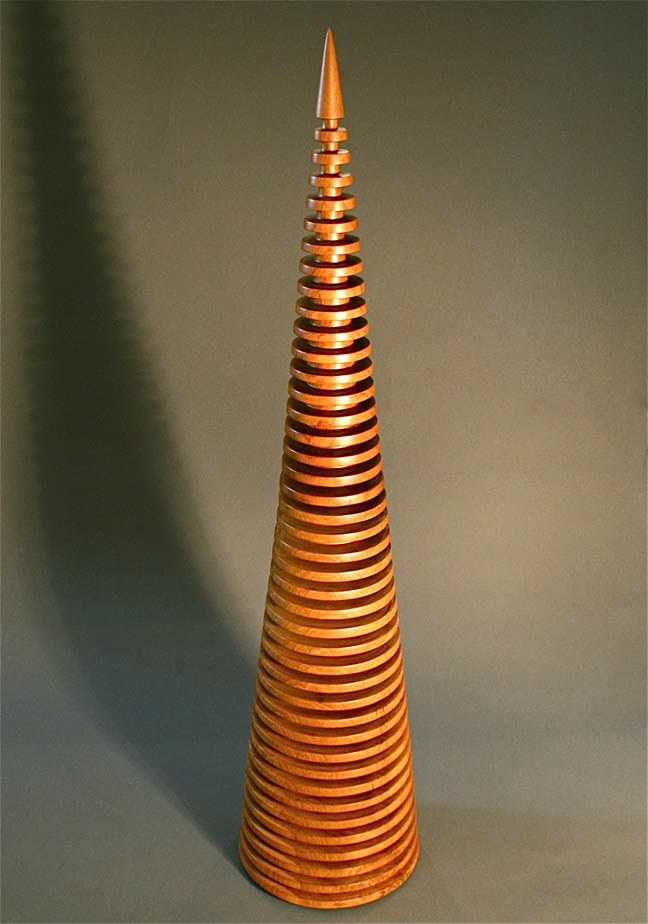

Title: Contemporary Architectural Art Element Wooden Tower Design Box
Shipping: $69.00
Artist: N/A
Period: Contemporary
History: N/A
Origin: North America > United States
Condition: Museum Quality
Item Date: 2000 to 2009
Item ID: 3800
Great Wood Carved Art Tower ! A very large hand made contemporary carved wood designed column capital box. This is a beautiful architectural element and a decorative object for a home or business. Just great wooden craftsmanship work, it is spectacular and unbelievable, stands proud and tall. Every graphic element of the architectural piece is skilfully design and carved.
Link: http://en.wikipedia.org/wiki/Decorative_arts
The decorative arts is a traditional term for a number of arts and crafts for the making of ornamental and functional works in a great range of materials including ceramic, wood, glass, metal, textiles and many others. The field includes ceramics, glassware, furniture, furnishings, interior design, but not usually architecture. The decorative arts are often categorized in opposition to the "fine arts", namely, painting, drawing, photography, and large-scale sculpture, which generally have no function other than to be looked at. Some distinguish between decorative and fine art based on functionality, intended purpose, importance, status as a unique creation, or single-artist production. Decorative arts, or furnishings, may be fixed (for example, wallpaper), or moveable (for example, lamps). Applied art includes the decorative arts but also graphic design and other categories, such as industrial design, which may overlap with decorative art. In general the term "decorative arts" is not much used of contemporary work, which tends to be called design instead. In art history the term minor arts is often used for the decorative arts.
The distinction between decorative and fine arts has essentially risen from the post-Renaissance art of the West, where it is for the most part meaningful. It is much less so when applied to the art of other cultures and periods, where the most highly-regarded works often include those in "decorative" media, or all works are in such media. For example, Islamic art in many periods and places consists entirely of the decorative arts, as does the art of many traditional cultures, and in Chinese art the distinction is less useful than in Europe. Even in Europe, the distinction is unhelpful for Early Medieval art, where although "fine arts" such as manuscript illumination and monumental sculpture existed, the most prestigious works, commissioned from the best artists, tended to be in goldsmith work or cast metals such as bronze. Large-scale wall-paintings were apparently much less regarded, relatively crudely executed, and rarely mentioned in contemporary sources; they were probably seen as a cheap but inferior substitute for mosaic, which in this period must be treated as a fine art, though in recent centuries contemporary production has tended to be seen as decorative. The term "ars sacra" ("sacred arts") is sometimes used for medieval Christian art in metal, ivory, textiles and other high-value materials from this period, though this does not cover the even rarer survivals of secular works.
Modern understanding of the art of many cultures tends to be distorted by the modern privileging of fine art media over others, as well as the very different survival rates of works in different media. Works in metal, above all in precious metals, are liable to be "recycled" as soon as they fall from fashion, and were often used by owners as repositories of wealth, to be melted down when extra money was needed. Illuminated manuscripts have a much higher survival rate, especially in the hands of the church, as there was little value in the materials and they were easy to store.
The promotion of the fine arts over the decorative in European thought can largely be traced to the Renaissance, when Italian theorists such as Vasari promoted artistic values, exemplified by the artists of the High Renaissance, that placed little value on the cost of materials or the amount of skilled work required to produce a work, but instead valued artistic imagination and the individual touch of the hand of a supremely gifted master such as Michelangelo, Raphael or Leonardo da Vinci, reviving to some extent the approach of antiquity. Most European art during the Middle Ages had been produced under a very different set of values, where both expensive materials and virtuoso displays in difficult techniques had been highly valued. In China both approaches had co-existed for many centuries: ink and wash painting, mostly of landscapes, was to a large extent produced by and for the scholar-bureaucrats or "literati", and was intended as an expression of the artist's imagination above all, while other major fields of art, including the very important Chinese ceramics produced in effectively industrial conditions, were produced according to a completely different set of artistic values.